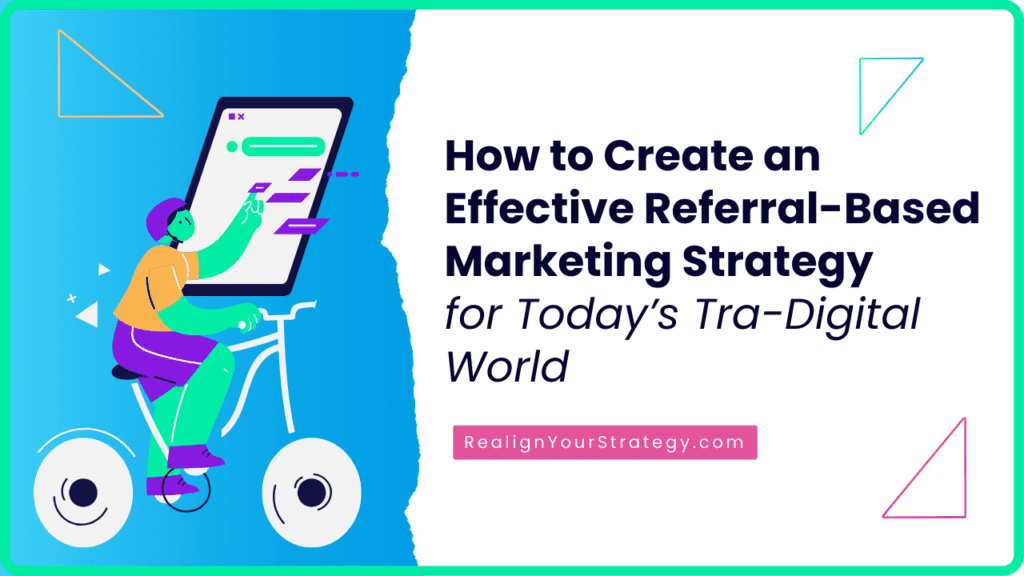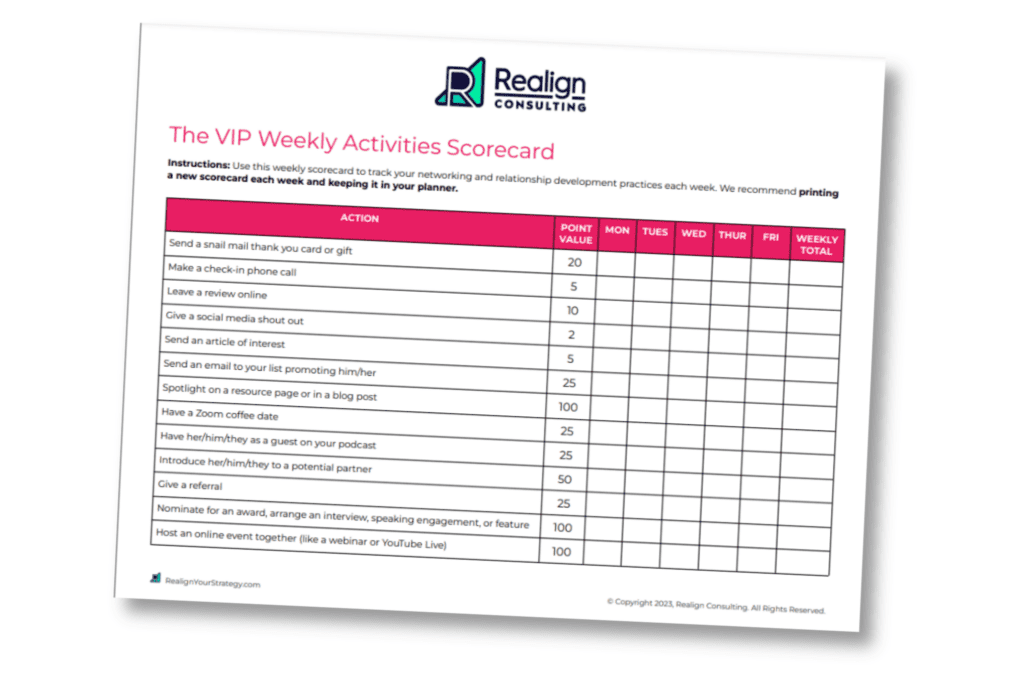Referral-based marketing should be a vital part of every business’s growth strategy. Being known within the communities you serve so that others become advocates for your work helps to direct a steady, reliable stream of business your way.
Unfortunately, there is currently a disconnect between most businesses’ marketing efforts and what it actually takes to build long-term, sustainable referral relationships. While many companies are still keeping their networking and community marketing separate from their online strategy, local-based, in-person groups—which have long been the central hub for referral-based marketing—are experiencing a resurgence.
After the intense digital focus of the past few years, people are searching for in-real-life connections—and they want it with the convenience of online communication built in.
To build sustainable, business-building relationships with local communities, small and mid-sized companies must follow a “tra-digital” marketing framework.
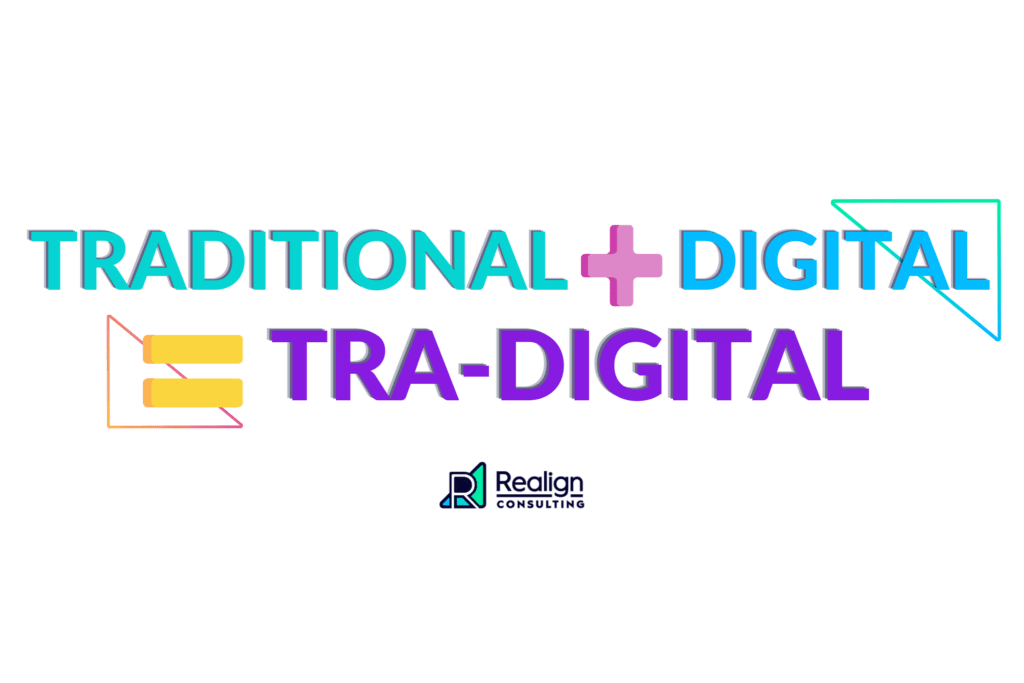
When we integrate the best from traditional in-person networking strategies with today’s digital tools, we can build a referral-based marketing foundation that works.
4 Keys to Building Relationships and Community Recognition with Intention
Engaging with local groups as a business owner should be as strategic as any other part of your marketing. From the perspective of values-driven marketing, this means honoring your time and energy while being authentic in your interactions.
These four steps can help you strike the right balance for you.
The first step to building a sustainable referral-based marketing strategy is to choose groups that make sense for you and your business.
Groups that are the right fit for you will fall into this intersection of criteria:
The group has the potential to be useful to your business.
The group should be made up of people who either reflect your stakeholder communities or who serve those communities. For example, this could be a professional organization in your industry where you could get suggestions about hiring. Or, it could be a volunteer group focused on an issue close to your heart that also gives you the opportunity to interact with your target market.
The group is well-organized and connected with each other.
You don’t need the frustration or the drama of a group that doesn’t know what it’s doing or is more interested in gossip than taking action.
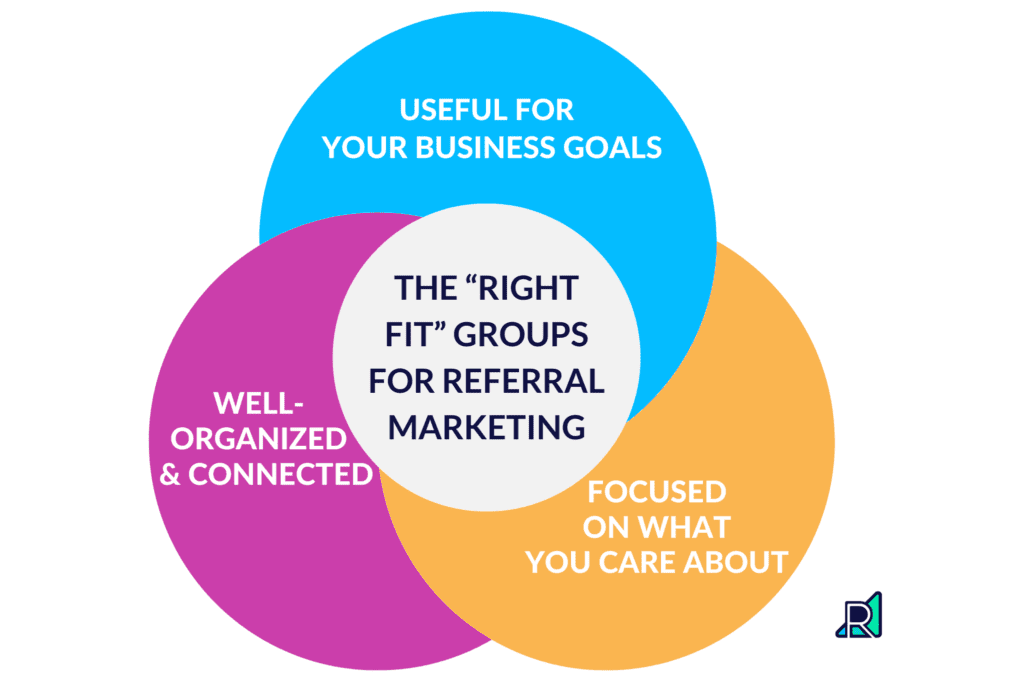
The group is focused on something you actually care about.
The group could be an industry-based organization, a volunteer group centered around something important to you, or even a hobby group. Connection is hard to establish if you’re not invested in what the group is doing.
The second step to choosing the right groups for your referral-based marketing strategy is identifying your goals and chances for joy.
As a business owner, your time is valuable. If you expend most of your energy engaging with groups that have a low chance of benefiting your business—or you find it difficult to be involved with—you’ve wasted opportunities that are better spent elsewhere.
- Even if you find a hobby group to be a part of, your focus must still be on your business. Take the time to identify the types of relationships you’re striving to build by being involved in this group.
- Then, consider your chances for joy. Can you see yourself looking forward to each group meeting? If joining this group fills you with dread—or apathy—then move on. You won’t build good relationships if you’re working with people you don’t like or are doing something you don’t enjoy.
The third step to being involved in local or community groups is to show up as a person, not a personal brand.
You can find a lot of referral-based marketing advice with outdated suggestions to focus on your personal brand when you’re networking.
They tell you to memorize a rote, impersonal elevator pitch, focus on getting your name out at all costs, curate your reputation, and otherwise treat your brand like a costume to pull out of the closet for every possible interaction.
When anyone can discover the basics of your company with a few taps on their phone, authenticity matters more than ever.
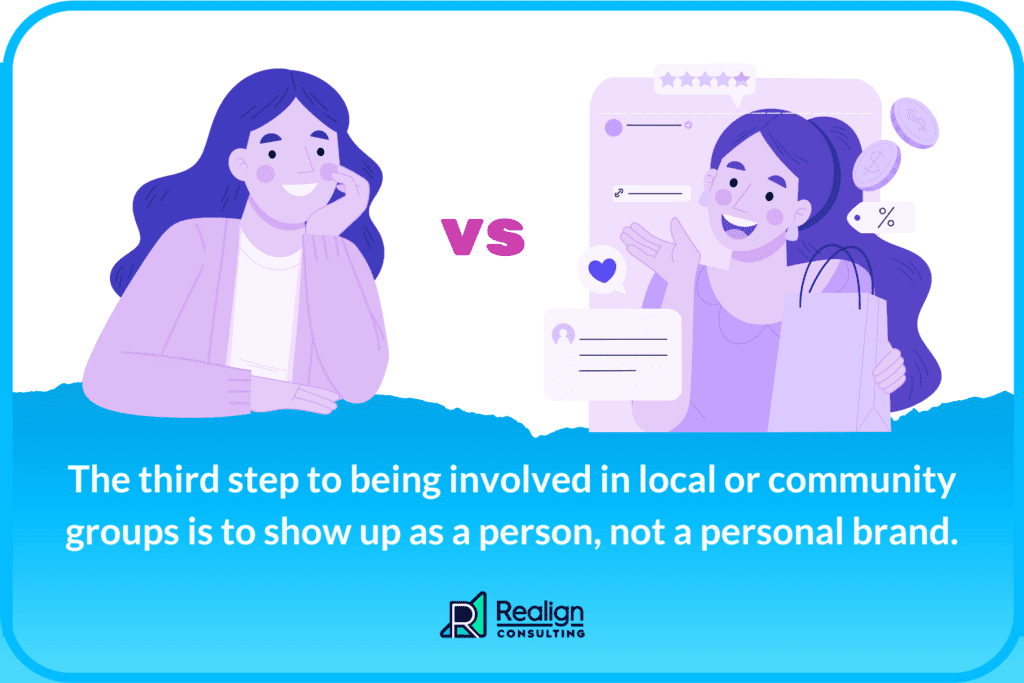
Respect the individual demands of your chosen group. Show up to make real connections based on shared values and beliefs, and dress in a way that makes sense for the group—if your brand is more “jeans and sandals” than “suits and ties,” but the group is more formal, leave the jeans at home.
You do need to consider the type of business owner you are—or even the type you’re building towards—when deciding how to show up at these organizations. But that should determine the way you expend your energy, not how you treat people.
For example, if you’re a one-person business, leading committees may not be the best use of your limited time. However, if you have a team to keep things running, you can probably afford to make that type of time investment.
Unsure about the type of business owner you are and how that relates to what your brand needs from you right now? Check out our fun and free Brand Archetype Quiz here.
The final step in deciding which organizations can help boost your referral-based marketing strategy is to know what to prioritize.
If your chosen organization is centered around volunteering (ie, non-profits), then your priority should not be networking.
If the organization is centered around networking (ie, Chambers of Commerce, Women in Business groups), then your priority should not be volunteering.

I learned this lesson the hard way when I first started out as a solopreneur. As a BNI director, I spent more time volunteering for the organization than I did on building my business, which meant I missed some important opportunities. This might be fine in a non-profit or advocacy environment, but when the purpose of the group is business, volunteering should be a secondary consideration.
- Understanding when it is appropriate to focus on networking and when not to is how you respect others.
- Understanding when you should invest more of your time in volunteering and when you need to protect your energy is how you respect yourself—and your business.
Referral-Based Marketing in Community: What You Need to Know
There are some terms and tools community-based businesses need to know to get the most out of your referral marketing—especially as you work to integrate your traditional, in-person strategies with digital platforms.
Sponsoring, Advocating, and Collaborating—What’s the difference and why does it matter?
As you build relationships in your community, it’s important to be clear about the parameters of the relationship. What is expected of you and your business, and what do you need to do to support that ongoing connection?
Sponsoring is giving money and or resources to get your company name on something.
It should be a part of the marketing budget and should be planned at the beginning of each year (or at least at the beginning of each quarter). It is important to be very strategic about how that money is given out. Many of us have finite resources, and even though we might like to sponsor everything, we can’t. What we choose to sponsor should be intentionally planned as part of the marketing strategy.
Advocating is when we are giving our personal power to help advance a cause, institution, person, or organization.
We are lending our credibility and our brand to that, but it's usually not money-driven. Advocating should be built into our relationship-building plan, and we should know that when we are advocating on behalf of someone else, we are putting our own personal integrity and brand on the line—and treat it as such. Some examples of advocating include sending out a blast to your email list about the other person’s business, leaving reviews, and introducing someone at a gala.
Collaborating is when we come together with other people or other brands to do some type of co-marketing.
Some examples of this include sending out newsletters together, co-sponsoring or co-creating an event, or being a guest on their podcast.
How Digital Engagement in Your Referral-Based Marketing Strategy Helps With Slow-Simmer Branding
If you are doing in-person community-based networking, take the time to connect with those groups online.
You may only meet with certain organizations and groups once or twice a month in person, and often less. By engaging with key relationships in a digital format as well, you’ll build them stronger and faster than you would otherwise.
LinkedIn is a great platform to nurture these types of relationships. Get our free LinkedIn 5 Tool here to help you build a simple routine for engaging with key people online.
Choose to strategically engage with people from your local environments instead of leaving it up to the whims of the algorithm
Search for what they’re producing, such as YouTube videos, podcasts, or newsletters. Subscribe to them, and then actually engage with the content. Message them with notes about what stood out for you, or respond to something they’ve posted on social.
I’ve seen this strategy work for clients and for my own brand. In fact, for several years after I stopped doing public appearances, people still thought I was everywhere because of the way that we were engaging with them online.
We weren’t spending money on ads or sponsoring anything. But I was intentionally present in local conversations, which kept me and my company top-of-mind.
I call this “slow simmer branding.” These actions were never going to explode into virality, but my company became the first thing people thought of when they—or their friends or colleagues—were looking for business help.
Using CRM Tools to Manage Relationships
If you want to be strategic about intentionally building a relationship-based business, you’re going to need to use CRM tools.
We provide each of our clients with our customized “VIP Scorecard” to support their referral-based marketing efforts. They integrate it with their CRM tools using things like lead scoring or tagging.
(Shout out to Dr. Ivan Misner’s Certified Networker Program circa 2009, where Renia first learned a version of a Networking Scorecard that was the original inspiration for what has become the VIP scorecard. Although we don’t endorse the current iterations of this program, the original was invaluable to the early stages of Realign Consulting’s thinking about referral based marketing. )
For example, every time a physical note, thank you card, or gift is sent in the mail to someone in your network, that counts for five points on the scorecard. An email note is only worth one point. This is logged in the CRM, so that over time there is both a qualitative and a quantitative measure of how much has been done to nurture and develop the relationship.
Although I often get a knee-jerk reaction about scoring relationships this way—because it doesn’t feel organic—the truth is that relationship development ALWAYS requires intentionality.
And, that old saying in business, “what gets measured gets noticed,” really is true here. By giving us a way to measure our relationship nurturing, we pay closer attention to the important actions needed to create deep connections.
And, when done with true empathy and care for the individuals, this intentionality is the most personally rewarding and business-sustaining type of work most of us will ever do as a part of our marketing.
Balancing Virtual Interactions with In-Person Engagements
A common issue I see with owners of small and mid-sized businesses who are using referral-based marketing is spending time at in-person events that could be better spent working on their business.
To strike a better balance, consider what could be achieved with today’s digital tools. This could look like limiting the in-person events to a few times a month, and then supplementing them with things like…
- Having a coffee date via Zoom
- Scheduling a “walk-and-talk” while you run errands
- Attending an event virtually
By striking a balance between in-person and online engagements, we can avoid overwhelm while still investing in relationships and connections that can help grow our business.
How we engage with communities matters for sustainability, growth, and joy.
Referral-based marketing is a powerfully sustainable way to grow a business. We make it even more effective when we combine the power of in-person connections with digital accessibility and convenience.
Many of us have allowed our marketing muscles to become atrophied when it comes to engaging with a place and the communities within it. It’s time to get back to building connections the old-fashioned way—with a little digital boost.
Get more DIY marketing tips
Check out our FREE guide to DIYing your digital marketing in 30 minutes a day.
We believe it’s possible to see results from your digital marketing in just 30 minutes a day—because we’ve done it, and so have our clients! Check out our free guide below (You’re going to want to bookmark this one!).

